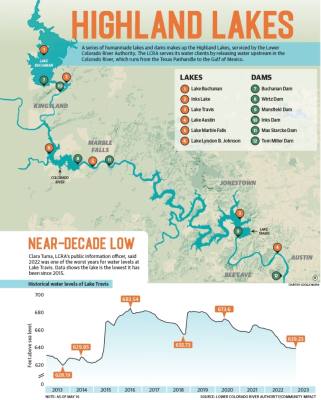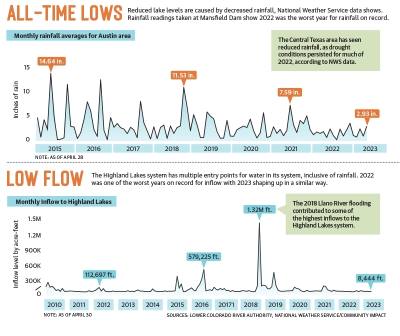Lower water levels have a profound impact on both the local business community and residents because the lake is well known as a spot for watersport vacationing, said Karen Shultz, the president of the Lake Travis Chamber of Commerce. As reduced lake levels fall below the accessibility of public boat ramps, Shultz said those who do not keep their boats at private dock slips in a marina may face some difficulty getting in the water.
“It affects the marina business and restaurants,” Shultz said. “People can’t just drag their boats up and get off and come up to the restaurant. It’s a bigger deal.”
The trend of low inflows—water entering the Highland Lakes system managed by the Lower Colorado River Authority via rainfall, tributary rivers• and groundwater—is also persisting into 2023, data shows.
The amount of water flowing into both Lake Travis and Lake Buchanan totaled just over 118,000 acre-feet, about 10% of average annual inflows, LCRA Public Information Officer Clara Tuma said. Even recent storm activity has not been enough to raise the lake’s level, LCRA data shows.
Impact to local businesses
In November, Community Impact reported that over the summer and fall some local businesses had seen lower traffic from visitors. Shultz said some more businesses have closed since then, including Kitchen Del Mar Seafood, Grill and Bar as well as Vincent’s on the Lake.
Historical data shows the lake has remained at around 640 mean sea level, just under 32 feet lower than its historical May average.
Roland Adams, the general manager of Crosswaters Yacht Club, who has operated multiple marinas on Lake Travis for over 20 years, said closings around the lake during low periods come down to a test of how that business is run and the bond built with the surrounding community.
“In reality, if that restaurant was run incredibly well, then people will find a way to get there,” Adams said.
He said business at Crosswaters has seen a slight decrease recently, which he attributed to a natural decline from 2020 highs. As people in the area sought outdoor activities, Adams said, they turned to boating. The marina is still doing well, he said, with a level of business comparable to 2019.
Adams is also president of the Marina Association of Texas and said other marinas may be having different experiences based on the lake’s topography. While some may have to relocate entirely based on the lake level, others such as Crosswaters are able to simply move farther into the lake.
“All the marinas on Lake Travis are table anchored, so they have winches and cables,” Adams said. “When you’re letting the marina go up and down, you’re adjusting it side to side, front and back. You’re constantly adjusting.”
Roger Duffee, general manager of MarineMax Sail & Ski, said his business has not been impacted by the lake levels as people continue to purchase boats from both his Lakeway and Austin locations.
However, he has heard from customers who have been experiencing some difficulty as low water levels prompt closures at public ramps. As of early May, only two public Lake Travis boat ramps are open.
“The challenge is for the people that choose to trailer their boat and use the public launch ramps,” Duffee said. “What would be ideal is if Travis County and the LCRA would invest in the infrastructure to extend boat ramps and continue to make the lake accessible for the people who are reliant on trailering.”
Conservation efforts
Following the yearslong trend of low water levels at Lake Travis, Shannon Hamilton, executive director of the Central Texas Water Coalition, said she is concerned about the region’s water supply as many cities draw water from the Highland Lakes system.
“Our biggest concern is there is no plan for a drought worse than the drought of record,” Hamilton said. “We’re highly concerned about the highland lakes.”
The LCRA manages a network of lakes and dams in Central Texas called the Highland Lakes. Located northwest of Austin, the lakes are in an arid part of the state that is prone to both flooding and drought. Made up of Lakes Buchanan, Inks, Lyndon B. Johnson, Marble Falls, Travis and Austin, the series of reservoirs receiving water from the Colorado River and its tributaries, rainfall and groundwater flows provide drinking water to more than 2.5 million people in Central Texas as well as irrigation for ranch and farm operations.
The lake system has been designed to weather periods of drought and flood since its creation in the 1940s, providing a reservoir for local entities to draw from, and is intended to fluctuate in this manner, according to the LCRA website.
Due to consumer usage and ongoing drought conditions, the LCRA announced in March that some agricultural customers are cut off from receiving water from the Highland Lakes system. The authority’s state-approved water management plan allows for interruptible customers, who purchase water at a lower rate with the knowledge that water can be cut off or reduced due to drought conditions.
John Hofmann, LCRA executive vice president of water, stated in a release that while the lake system contains enough drinking water to serve firm customers—who purchase water that will be available even in times of drought—all LCRA customers should work to conserve water.
The water authority remains in the first stage of its drought contingency plan, which went into effect in July 2022, when the combined storage of water in lakes Buchanan and Travis reached 1.2 million acre-feet, requiring firm customers, which are mostly municipalities and utility districts, to decrease usage by 5%.
Should the combined storage fall below 900,000 acre-feet, the LCRA will move into stage two of its plan and will ask firm customers to reduce usage by 10%-20%. Without improved inflows, LCRA staff estimates this low-water thresh•old could be reached this summer.
Hamilton attributed upticks in usage to the increased population as well as increases in upstream irrigation. She said smaller ranches divided from larger, older ranch operations are entitled to 200 acre-feet of water each if located on the river, and the owners of these ranches often created stock and vanity ponds.
"The big ranchers of the past were very conservative with water,” Hamilton said. “They lived through droughts and knew what it took to keep water flowing.•”
Watercraft safety
While low water levels may sound like alarm bells to those unfamiliar with boating on Lake Travis, Adams said the water is still safe for boating activities.
“The people that actually have a marina really have a huge advantage because they have access to the lake when it has a decreased usage, which is actually a real pleasure,” Adams said.
In addition to simply having less usage, which translates to fewer people on the lake, Adams said the lake’s low periods provide an opportunity for boat operators to become more familiar with the topography of the lake and enhance their skills.
“If you’re gonna be reckless, you’re gonna be reckless, and you’re gonna run aground,” Adams said. “If you take the time to learn the lake, then you can run it at any level.”







